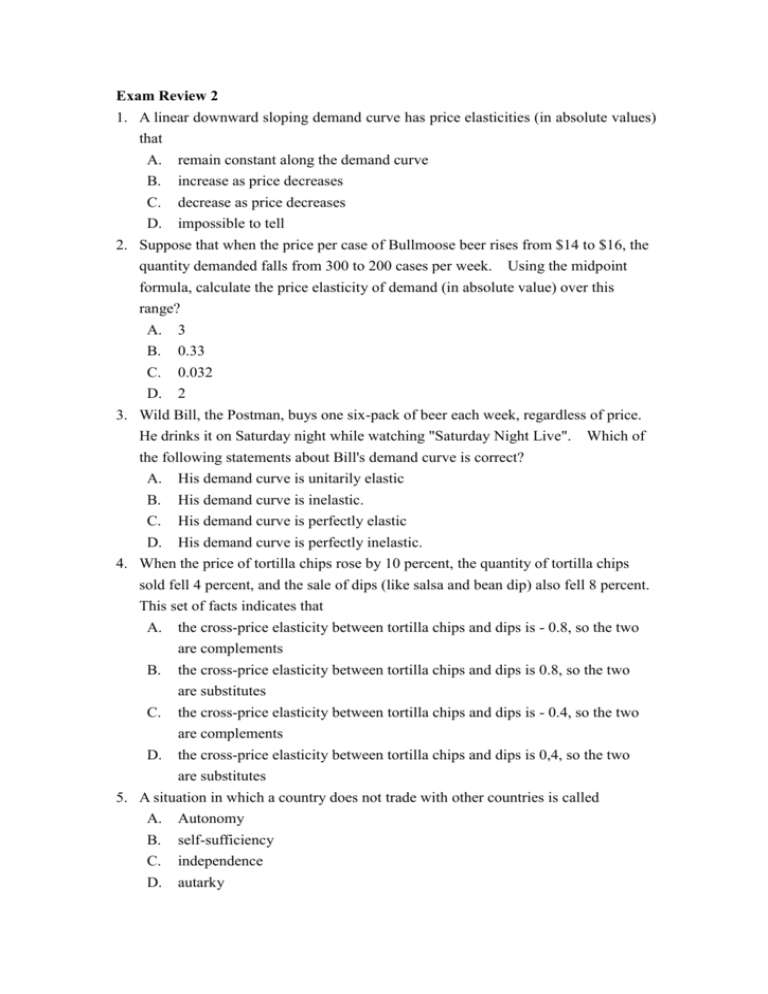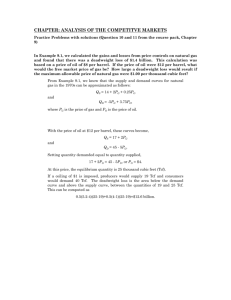Economics Exam Review: Elasticity, Trade, Costs
advertisement

Exam Review 2 1. A linear downward sloping demand curve has price elasticities (in absolute values) that A. remain constant along the demand curve B. increase as price decreases C. decrease as price decreases D. impossible to tell 2. Suppose that when the price per case of Bullmoose beer rises from $14 to $16, the quantity demanded falls from 300 to 200 cases per week. Using the midpoint formula, calculate the price elasticity of demand (in absolute value) over this range? A. B. C. 3 0.33 0.032 D. 2 3. Wild Bill, the Postman, buys one six-pack of beer each week, regardless of price. He drinks it on Saturday night while watching "Saturday Night Live". Which of the following statements about Bill's demand curve is correct? A. His demand curve is unitarily elastic B. His demand curve is inelastic. C. His demand curve is perfectly elastic D. His demand curve is perfectly inelastic. 4. When the price of tortilla chips rose by 10 percent, the quantity of tortilla chips sold fell 4 percent, and the sale of dips (like salsa and bean dip) also fell 8 percent. This set of facts indicates that A. the cross-price elasticity between tortilla chips and dips is - 0.8, so the two are complements B. the cross-price elasticity between tortilla chips and dips is 0.8, so the two are substitutes C. the cross-price elasticity between tortilla chips and dips is - 0.4, so the two are complements D. the cross-price elasticity between tortilla chips and dips is 0,4, so the two are substitutes 5. A situation in which a country does not trade with other countries is called A. Autonomy B. self-sufficiency C. independence D. autarky 6. Refer to the following figure. The supply of dorm rooms at a college campus today is best represented by which diagram? A. Graph A B. Graph B C. Graph C D. none of the above 7. Which of the following does not explain why we do not see complete specialization in the production goods and services? A. B. C. As demand for imported goods rise, domestic suppliers will increase output to compete with foreign producers As more exported goods are produced, the opportunity cost of producing additional units eventually increase Most products are differentiated therefore some buyers may prefer to purchase a domestically produced as opposed to a similar good produced abroad D. Not all goods and services are traded internationally 8. Refer to figure below. If there was no quota, how many pounds of peanuts would domestic consumers purchase and what quantity would be imported? A. 40 million pounds of which 30 million pounds will be imported B. 28 million pounds of which 18 million pounds will be imported C. 40 million pounds of which 12 million pounds will be imported D. 40 million pounds all of which will be imported 9. Refer to figure from Question 8. Suppose a quota is imposed that limits imports to 16 million pounds. What happens to the domestic price of peanuts A. It drops to $1.00 per pound B. It rises to $3.75 per pound C. It rises to $2.75 per pound D. It stays at $2.00 per pound; only the quantity consumed is affected 10. The infant-industry argument for protectionism holds that A. domestic producers will be better able to compete in world markets in the future if they are given time to achieve significant economies of scale B. that an industry must be protected in the early stages of its development so that firms will be protected from subsidized foreign competition C. some strategic industries such as the jet fighter plane industry must be protected so that there will be adequate supplies of crucial resources in case they are needed for national defense D. domestic producers in high-wage countries must be protected from foreign producers in low-wage countries to level the playing field 11. If marginal utility is diminishing and is a positive amount A. total utility will increase B. total utility will decrease. C. the consumers get no satisfaction from consuming the good D. the consumer has gone beyond her optimal consumption 12. Refer to table below. Suppose Antonio has $10 to spend on the two goods and the price of beer = $2 per glass and the price of pizza = $2 per slice. What is his utility-maximizing bundle? A. 2 glasses of beer, 1 slice of pizza B. 2 glasses of beer, 3 slices of pizza C. 3 glasses of beer, 2 slices of pizza D. 4 glasses of beer, 5 slices of pizza Quantity of Beer (glasses) Total Utility Quantity of Pizza (slices) Total Utility 1 25 1 20 2 45 2 35 3 60 3 45 4 65 4 50 5 69 5 52 6 70 6 52 13. The French Bakery ran a special on its croissants in which the price decreased from $1.50 to $1.00. Anna figured that although her money income has not changed, her purchasing power has increased and so she buys more than her usual amount. What effect does this capture? A. the income effect B. the substitution effect C. the price effect D. the consumption effect 14. Suppose you pre-ordered a non-refundable movie ticket to "Harry Potter and the Goblet of Fire". On the day of the movie you decide that you would rather not go to the movie. According to economists, what is the rational thing to do? A. Since the cost of the movie ticket is a sunk cost, it should not influence your decision. Your decision should be based solely on whether you want to see the movie or not B. You should not waste resources. Since you have paid for the ticket you should watch the movie C. Your should go to the movie to minimize your loses D. You should go to the movie to maximize your gain 15. Which of the following statements best describes the economic short run? A. It is a period of one year or less B. It is the time period during which firms are free to vary all their inputs C. It is the time period during which some inputs are fixed and some inputs are variable D. It is the period during which fixed inputs become variable because of depreciation 16. Which of the following is an example of an explicit cost of production? A. the cost of forgone labor earnings for an entrepreneur 40 bushels B. the lost opportunity to invest in other financial assets when the money is invested in one’s business C. the cost of flour for a baker D. All of the above 17. In a small confectionery that hires 4 workers, hiring a 5th worker actually lowers total output. Which of the following statements is false? A. The marginal product of the fifth worker is negative B. Currently, the marginal cost of hiring the fifth worker outweighs the marginal benefit C. The slope of the production function is negative D. The average product of the fifth worker is negative 18. A producer's average total cost must fall as output expands if its marginal cost A. B. C. is greater than average total cost and falling is less than average total cost and falling is falling, regardless of whether marginal cost is greater or less than average total cost D. is less than average total cost, regardless of whether marginal cost is rising or falling 19. Refer to Figure below. When output level is 100, average fixed cost is A. $8 B. $10 C. $5 D. cannot be determined from the diagram 20. Economies of scale occur when A. B. C. D. long-run average cost falls as new firms enter the industry long-run average cost falls as one firm expands plant size short-run average cost falls as one firm expands plant size long-run average cost rises as one firm expands plant size Short Questions: 1. Use the figure below to answer the following questions a. b. c. d. e. f. 2, Calculate the fixed cost of production Calculate the average total cost of production when output the firm produces 20 units Calculate the average variable cost of production when the firm produces 20 units Calculate the average fixed cost of production when the firm produces 20 units Calculate the average fixed cost of production when the firm produces 15 units When the firm increases output from 15 to 20 units, calculate the marginal cost per unit of output Bragabong currently both produces and imports almonds. The government of Bragabong then decides to restrict international trade in almonds by imposing a quota that allows imports of only 10 million kilos each year. Figure below shows the estimated demand and supply curves for almonds in Bragabong and the results of imposing the quota. Answer questions a-j using the Figure a. If there is no quota, what is the domestic price of almonds and what is the quantity of almonds demanded by consumers? b. If there is no quota, how many kilos of almonds would domestic producers supply and what quantity would be imported? c. If there is no quota, what is the dollar amount consumer surplus? d. If there is no quota, what is the dollar amount of producer surplus received by producers in Bragabong? e. If there is no quota, what is the revenue received by foreign producers who supply almonds to Bragabong? f. With a quota in place, what is the price that consumers of Bragabong must now pay and what is the quantity demanded? g. With a quota in place, what is the dollar amount consumer surplus? Are consumers better off? h. With a quota in place, what is the the dollar amount of producer surplus received by producers in Bragabong? Are domestic producers better off? i. Calculate the revenue to foreign producers who are granted permission to sell in Bragabong after the imposition of the quota? j. 3. Calculate the deadweight loss as a result of the quota? Using the information below, calculate the income elasticity of demand for good X and characterize the good. Use the midpoint formula. Can you calculate the income elasticity of demand for good Y? If you can, show your calculation and characterize the good. If you cannot explain why. Quantities Purchased Income Price Good X Good Y $30,000 Px = $6, Py = $3 2 20 $50,000 Px = $6, Py = $4 5 10







